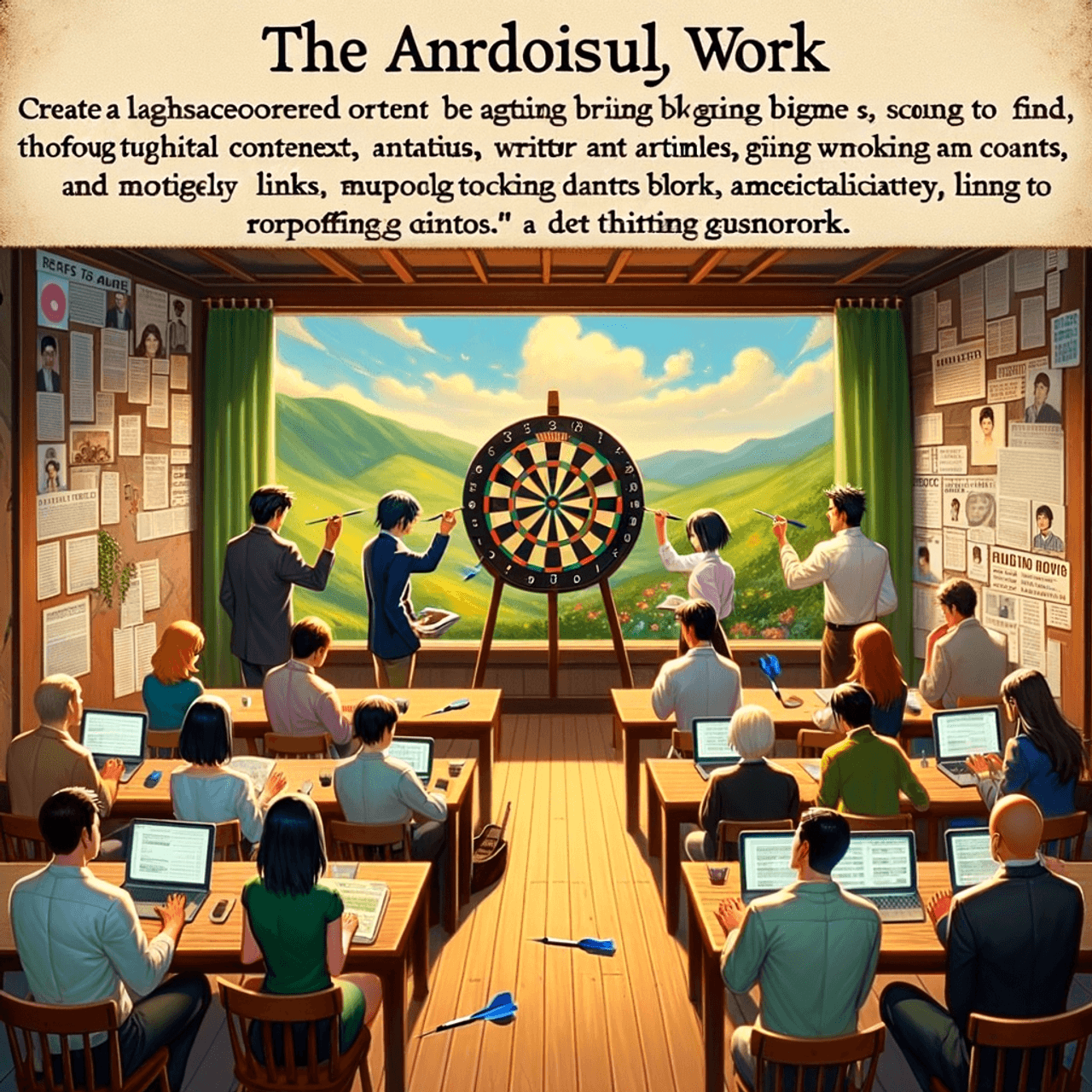by ContentERP | Oct 23, 2024 | Uncategorized
5 Newsletter Best Practices for Optimized Content, From the Experts at ContentERP
Once upon a time, newsletters were simple. You’d draft up some text, throw in a link or two, and send it out into the digital ether, hoping it would land in inboxes like a message in a bottle. But those days are long gone. In today’s fast-paced digital world, newsletters have evolved into powerful marketing tools that demand precision, strategy, and creativity. Without the right approach, your newsletter could vanish into the abyss of unopened emails, joining the ranks of forgotten messages.
 But fear not! The experts at ContentERP are here to guide you through five best practices that will ensure your newsletters not only get opened but also engage, inform, and convert. It’s time to take your content strategy to the next level and make every newsletter count.
But fear not! The experts at ContentERP are here to guide you through five best practices that will ensure your newsletters not only get opened but also engage, inform, and convert. It’s time to take your content strategy to the next level and make every newsletter count.
Related: How to Boost Traffic by Automating Your Content Flow: A Guide with a Twist
1. Craft Irresistible Subject Lines
Imagine this: Your audience is swiping through dozens of emails, each clamoring for attention like a street vendor in a crowded marketplace. The first thing they see? Your subject line. This is your moment to shine, and if you miss it, your email is headed straight for the dreaded trash folder.
Think of your subject line as a front door—it needs to be inviting enough for readers to want to step inside. The key is to keep it short (under 50 characters), make it intriguing, and avoid being too salesy. Use humor, questions, or even a touch of mystery to pique curiosity. Something like “Unlock the Secret to Boosting Your Sales” or “Are You Missing Out on These Marketing Trends?” will do the trick.
And don’t forget to A/B test your subject lines. What resonates with one segment of your audience may fall flat with another. Let ContentERP’s tools help you test, analyze, and refine your approach so you can consistently hit that sweet spot.
2. Focus on Personalization
There’s something magical about seeing your own name in an email, isn’t there? It’s as if the sender is speaking directly to you. That’s the power of personalization—and it goes far beyond just using a first name.
With personalized newsletters, you’re not simply addressing readers; you’re engaging them. Tailor your content based on user behavior, interests, and demographics. Segment your audience so that the content they receive is relevant and specific to their needs.
For instance, if you know a segment of your audience is interested in SEO, send them updates about the latest SEO strategies, tips, or tools—like those found on ContentERP. The more targeted your content, the more likely readers are to stay engaged, and the more they’ll trust you as a valuable source of information.
3. Use Clean, Engaging Design
If your subject line is the front door, then your email’s design is the interior décor. Imagine walking into a cluttered, dimly lit room—you’d want to leave as quickly as possible, right? That’s exactly what happens when your newsletter is poorly designed.
Clean, simple, and visually appealing newsletters make it easy for readers to digest your content. Stick to a single-column layout, with plenty of white space and clear headings. Don’t overwhelm readers with blocks of text—break it up with engaging visuals, bullet points, and even the occasional GIF or meme (if it suits your brand’s tone).
Mobile optimization is another must. More than half of emails are opened on mobile devices, so make sure your newsletter looks just as good on a smartphone as it does on a desktop. Luckily, ContentERP’s design tools can help you build beautiful, responsive newsletters that capture attention, no matter where they’re opened.
4. Create a Clear Call to Action (CTA)
Your newsletter has done its job—engaged the reader, shared valuable information—but now, what’s next? This is where a clear, compelling call to action (CTA) comes into play.
Your CTA should be direct and concise, guiding readers toward a specific action, whether it’s reading your latest blog post, downloading an e-book, or signing up for a demo. And remember, not all CTAs need to be about sales—sometimes, you just want to build a relationship. Invite readers to share their thoughts, follow you on social media, or participate in a webinar.
It’s also important to make your CTA visually stand out. Use contrasting colors and actionable language like “Discover More,” “Get Started,” or “Sign Up Now.” At ContentERP, we’ve mastered the art of crafting compelling CTAs that convert, and we’re ready to help you do the same.
5. Test and Analyze for Continuous Improvement
Here’s a secret that many forget: The best newsletters are constantly evolving. What worked last month may not work today, and that’s okay—because you have the power to test, adjust, and improve.
By regularly analyzing open rates, click-through rates, and conversions, you can see what’s resonating with your audience and what isn’t. Test different subject lines, designs, content formats, and even the timing of your sends. Each tweak brings you closer to a perfectly optimized newsletter.
With ContentERP, you can track performance metrics in real-time, ensuring you’re always a step ahead of your competitors. Armed with this data, you’ll be able to make informed decisions that drive engagement and growth.
Conclusion: Crafting Newsletters That Delight
 Now, picture this: The soft glow of a laptop screen, the rhythmic tap of fingers on keys, and the sense of anticipation as you hit “send” on your latest newsletter. You’ve done the work—crafted the perfect subject line, personalized your message, optimized your design, and laid out a clear path for readers to follow. As your email sails through cyberspace, you can almost feel the excitement of those who will open it, click through, and engage with your brand.
Now, picture this: The soft glow of a laptop screen, the rhythmic tap of fingers on keys, and the sense of anticipation as you hit “send” on your latest newsletter. You’ve done the work—crafted the perfect subject line, personalized your message, optimized your design, and laid out a clear path for readers to follow. As your email sails through cyberspace, you can almost feel the excitement of those who will open it, click through, and engage with your brand.
Newsletters aren’t just messages—they’re your voice, your connection to an audience who looks to you for information, guidance, and solutions. And with these five best practices in mind, you’re on your way to building a newsletter strategy that doesn’t just exist in inboxes but truly stands out.
But here’s the thing: you don’t have to navigate this journey alone. With ContentERP, you have all the tools you need to create newsletters that resonate, convert, and build lasting relationships. Whether you’re just starting or looking to refine your current approach, ContentERP can help you design, deliver, and optimize content that will elevate your brand.
Ready to take your newsletters to the next level? Sign up for ContentERP today and watch your content soar to new heights!
by ContentERP | Oct 23, 2024 | Uncategorized
How Can These 5 SEO Content and Design Tips Improve Your Ranking in SERPs?
 Picture this: You’ve poured hours into creating the perfect website content. It’s thoughtful, detailed, and exactly what your audience needs. Yet, somehow, it remains buried on the second or third page of Google search results—a place where even the most diligent users rarely venture. What’s missing? Why isn’t your carefully crafted content climbing the coveted ladder to the top of search rankings?
Picture this: You’ve poured hours into creating the perfect website content. It’s thoughtful, detailed, and exactly what your audience needs. Yet, somehow, it remains buried on the second or third page of Google search results—a place where even the most diligent users rarely venture. What’s missing? Why isn’t your carefully crafted content climbing the coveted ladder to the top of search rankings?
The truth is, high-quality content alone isn’t enough. It’s like throwing a party without sending out invitations. You might have the best offerings, but if no one knows you exist, you’ll be celebrating alone. To break through the noise and gain the visibility your content deserves, your SEO and website design need to work hand-in-hand like a perfectly choreographed dance. And when they do, the results can be magical.
So, how exactly do you make sure your content gets the attention it deserves? Here are five crucial SEO content and design tips to help you boost your ranking in search engine results pages (SERPs), enhance your user experience, and capture the spotlight you’ve been seeking.
Related: How to Boost Traffic by Automating Your Content Flow: A Guide with a Twist
1. Master the Art of Keyword Placement—But Don’t Overdo It
Keywords are like breadcrumbs leading Google to your site. But just like too much salt can ruin a dish, overstuffing your content with keywords can do more harm than good. The key is to strike the perfect balance: carefully selecting keywords that resonate with your target audience, then weaving them into your content in a way that feels natural, rather than forced.
Start by identifying a primary keyword for each piece of content, something highly relevant to your subject matter. Then, use variations of that keyword (long-tail keywords) to catch a broader range of search queries. Incorporating them into your title, headers, and meta description is crucial, but make sure they flow with the context. Remember, search engines may be bots, but they reward writing that sounds like it was written by a human, for a human.
Pro Tip: Use ContentERP to track high-performing keywords for your niche. The AI-powered platform analyzes search trends and provides suggestions that are both relevant and impactful—taking the guesswork out of SEO.
2. Make Your Design Mobile-Friendly—Because Google Says So
It’s no secret that mobile traffic now dominates the digital space. More than half of all internet traffic comes from mobile devices, and Google’s algorithms prioritize mobile-friendly websites when determining search rankings. This means that if your site looks clunky or performs poorly on mobile, you’ll likely be sent to the back of the line.
What can you do? Start by using responsive design, ensuring that your content automatically adjusts to different screen sizes and devices. Clean layouts, fast load times, and touch-friendly navigation are essential elements of mobile optimization.
Think of mobile users as VIP guests at your SEO party—if you don’t cater to them, they won’t stick around for long. And neither will Google.
3. Focus on Page Load Speed—Don’t Keep Visitors (or Google) Waiting
There’s nothing more frustrating than waiting for a webpage to load. It’s like standing in front of a closed door, knocking repeatedly, only to get no response. In fact, most users will abandon a site that takes longer than three seconds to load, and Google knows this. Page speed is a critical ranking factor in SEO.
To boost your speed, minimize the size of your images, use caching, and limit the number of plugins on your site. Compress your website’s code and utilize Content Delivery Networks (CDNs) to ensure that your content is delivered as quickly as possible.
Remember, a slow-loading website doesn’t just harm your search rankings; it also irritates your visitors. And irritated visitors rarely return.
Related: Why ContentERP is the Best Choice for Startups Looking to Build Their Brand
4. Write for Humans, Optimize for Search Engines
Let’s face it—nobody wants to read content that sounds like a robot wrote it. Yet, in the pursuit of SEO glory, too many content creators fall into the trap of writing for algorithms instead of actual people. Here’s the secret: you can do both.
By crafting engaging, informative, and well-structured content that delivers real value to readers, you naturally increase your SEO performance. Search engines have grown smarter—they recognize when users are spending more time on a page and reward that engagement with better rankings.
Break up your content with subheadings, bullet points, and images to make it more readable. And don’t forget internal linking, which not only improves SEO but also keeps visitors exploring your site longer.
Pro Tip: Analyze your content’s readability score and SEO compatibility in real time, so you’re never forced to choose between appealing to readers and search engines.
5. Optimize Your Metadata—The Unsung Hero of SEO
You wouldn’t publish a novel without a title or book cover, right? Think of your metadata—your title tags, meta descriptions, and image alt texts—as your content’s cover letter. While not visible to readers on the page, metadata is one of the first things search engines see, and it helps them determine the relevance of your content.
Your title tag should include your primary keyword, be no longer than 60 characters, and accurately describe what your page is about. Meanwhile, your meta description—those 160 characters below your title tag—should be written to entice readers, as it often determines whether someone clicks on your link or skips it.
Pro Tip: ContentERP’s AI-driven platform can auto-generate metadata optimized for both search engines and readers, saving you time while ensuring your site is always performing at its best.
Your Content’s Journey to the Top Starts Now
 Picture your content as a finely tuned orchestra—each piece working in harmony to create a symphony that resonates with both users and search engines. When your SEO strategy is in sync with your website design, the results can be transformative. Suddenly, you’re not just visible—you’re the main attraction, topping search rankings and driving more traffic than ever before.
Picture your content as a finely tuned orchestra—each piece working in harmony to create a symphony that resonates with both users and search engines. When your SEO strategy is in sync with your website design, the results can be transformative. Suddenly, you’re not just visible—you’re the main attraction, topping search rankings and driving more traffic than ever before.
And here’s the most exciting part: you don’t have to navigate this SEO journey alone. ContentERP is the conductor that will help orchestrate your content’s rise to the top. With its AI-driven tools, intuitive design, and strategic insights, you’ll never feel lost in the chaotic world of SEO again.
It’s time to unlock the full potential of your content. Sign up for ContentERP today, and watch your search rankings soar—one optimized page at a time.
Related: How to Maximize Content Promotion with Fewer Resources
by ContentERP | Oct 23, 2024 | Uncategorized
Are You Tapping Into the Full Value of Generative AI for Your Content?
 I remember my childhood trip to Madagascar like it was yesterday. Picture this: a sun-drenched day, the smell of salty ocean air swirling around me, and the sound of waves gently kissing the shore. My family and I had just trekked through the dense, otherworldly rainforests, where we marveled at the sight of lemurs leaping from tree to tree, and the vibrant flash of rare birds flitting through the canopy. It was a place where nature seemed to pulse with life, and everything was a little bit wild.
I remember my childhood trip to Madagascar like it was yesterday. Picture this: a sun-drenched day, the smell of salty ocean air swirling around me, and the sound of waves gently kissing the shore. My family and I had just trekked through the dense, otherworldly rainforests, where we marveled at the sight of lemurs leaping from tree to tree, and the vibrant flash of rare birds flitting through the canopy. It was a place where nature seemed to pulse with life, and everything was a little bit wild.
But it wasn’t the animals or the jungle that stayed with me the most—it was the moment we stopped in a tiny village. There, a group of local children showed me how they created colorful, intricate paintings using simple tools: palm leaves, sand, and crushed berries. What struck me most was how, despite their limited resources, they were able to craft something so vibrant and full of life. With a few natural materials and a lot of creativity, they turned the ordinary into the extraordinary.
That moment reminds me of what generative AI can do for content creation today. It’s like having an endless supply of tools and possibilities at your fingertips, ready to help you create something that stands out—no matter your starting point. But, just like the children in Madagascar, you have to know how to use those tools to their fullest potential. So, are you really tapping into the full value of generative AI for your content strategy? Or are you, like so many, just scratching the surface?
Related: Why Quality Content Starts with ContentERP’s Proofreading and Editing Tools
Unlocking the Potential: Generative AI, Your Creative Ally
Generative AI is no longer a distant technology of the future—it’s the here and now, revolutionizing how content is created. Think of it as your creative ally, tirelessly brainstorming, drafting, and optimizing without breaking a sweat. Need an SEO-friendly blog post? Generative AI can deliver. Looking to churn out product descriptions that convert? It’s got you covered. From clever social media copy to in-depth thought leadership articles, this AI generator can do it all.
But just like those kids in Madagascar, who knew how to take simple elements and create something magical, success with generative AI depends on how you use it. It’s not just about automating content production; it’s about leveraging AI to enhance your voice, optimize your reach, and craft pieces that resonate on a deeper level.
 Beyond Automation: Generative AI as Your Strategic Partner
Beyond Automation: Generative AI as Your Strategic Partner
Many view generative AI as a tool to merely speed up content creation. Yes, it can certainly take on the heavy lifting—churning out thousands of words in the blink of an eye—but the real value lies in its ability to generate strategic insights and unlock creative directions you might never have considered.
Picture generative AI as a content strategist sitting beside you, guiding your choices. It analyzes what’s working in the market, finds gaps in content, and offers unique ideas based on data-driven insights. This AI generator doesn’t just create content—it helps you understand what content will work best, where it should be distributed, and how it can engage your audience in the most effective way possible.
Are you a startup trying to gain traction? Generative AI can offer you a content roadmap that will save you time, resources, and headaches. Are you an established brand looking to stay ahead of the curve? With generative AI, you can refine and scale your content strategy, pushing boundaries and staying ahead of competitors in an increasingly crowded digital space.
Making the Most of Generative AI with ContentERP
While many platforms claim to offer AI content generation, ContentERP goes above and beyond by not only providing cutting-edge generative AI tools but also offering a seamless experience tailored to your specific needs. Like a master craftsman who knows which tools to use for each job, ContentERP’s AI generator ensures that each piece of content is polished, optimized, and aligned with your brand’s voice and goals.
Here’s where the magic happens: ContentERP combines the precision of AI with the nuance of human creativity. You can feed the AI specific details about your target audience, tone, and goals, and watch as it produces content that’s far from generic. From blog articles and social media posts to detailed reports and whitepapers, ContentERP helps you harness the full potential of AI without losing the unique touch that makes your brand stand out.
What’s more, ContentERP’s AI generator is equipped with real-time SEO optimization, meaning that the content it produces isn’t just creative—it’s primed to perform. The AI analyzes trends, keywords, and competitor strategies, allowing your content to rank higher on search engine results pages (SERPs) and drive more organic traffic to your site.
Call to Action: Don’t Miss Out on the Power of Generative AI
 Just as those children in Madagascar taught me the art of transforming simple elements into something unforgettable, generative AI offers you the same chance to turn basic ideas into impactful, strategic content. But here’s the catch: the true potential of AI lies in how you use it. Are you ready to let AI handle the mundane so you can focus on innovation?
Just as those children in Madagascar taught me the art of transforming simple elements into something unforgettable, generative AI offers you the same chance to turn basic ideas into impactful, strategic content. But here’s the catch: the true potential of AI lies in how you use it. Are you ready to let AI handle the mundane so you can focus on innovation?
With ContentERP, you’re not just using generative AI—you’re unlocking its full value. Now is the time to embrace the future of content creation. Imagine never staring at a blank screen again, knowing that with a few clicks, you’ll have content that not only captures your audience’s attention but also climbs the ranks of search engines.
Ready to take the leap? Sign up with ContentERP today and let’s start crafting content that doesn’t just fill space, but sparks conversations, builds trust, and drives growth.
A Journey Worth Taking
As I stood there in that Madagascar village, surrounded by the hum of life and creativity, I realized something profound: the power to create something beautiful and lasting often comes from unexpected places. Much like the children with their simple tools, generative AI is a tool that, when used wisely, can elevate your content to new heights.
The scent of rain on the air, the warmth of the sun on my face—those memories stir something deep inside. They remind me that sometimes, the greatest opportunities lie just beneath the surface, waiting for us to tap into them. Are you ready to unlock the full potential of generative AI and see where it takes you?
Sign up for ContentERP today. The future of content creation is waiting for you.
Related: Why ContentERP is the Best Choice for Startups Looking to Build Their Brand
by ContentERP | Oct 23, 2024 | Uncategorized
8 SEO Content Errors, Myths, and Misunderstandings from ContentERP’s Perspective
 Have you ever tripped over a content error that sent you tumbling down the rankings? The world of SEO is rife with myths and misunderstandings that can lead even the most seasoned content creators astray. Today, we unravel eight of these common pitfalls and misconceptions, casting light on how ContentERP’s insights can steer you toward a more successful content strategy.
Have you ever tripped over a content error that sent you tumbling down the rankings? The world of SEO is rife with myths and misunderstandings that can lead even the most seasoned content creators astray. Today, we unravel eight of these common pitfalls and misconceptions, casting light on how ContentERP’s insights can steer you toward a more successful content strategy.
Related: How to Create Evergreen Content that Continues to Drive Traffic
1. Keyword Stuffing: The Not-So-Sneaky Secret
Picture this: You’re at a dinner party, and your friend can’t stop repeating the same anecdote. Annoying, right? This is precisely what keyword stuffing feels like to search engines. In the quest for SEO supremacy, many writers still believe that loading content with keywords will guarantee a top spot on search results. However, search engines have evolved, prioritizing quality over quantity. The lesson? Instead of trying to cram in every keyword like a too-full suitcase, focus on natural, contextually relevant usage. Your audience—and Google—will thank you.
2. Content Length: More Is Always Better?
Ah, the myth that longer content is inherently better. While it’s true that comprehensive articles often perform well, it’s not the length that counts; it’s the value. Think of content like a good novel. A gripping story doesn’t rely on page count but on engaging plotlines and relatable characters. Craft content that resonates with your audience, whether it’s 500 words or 5,000. The key is to provide insights and information that keep readers on the edge of their seats.
3. All SEO Tools Are Created Equal
In a world full of shiny tools and gadgets, it’s easy to believe that all SEO tools are cut from the same cloth. However, different platforms serve different purposes. ContentERP stands out in a crowded marketplace, offering unique features that cater specifically to content creators. Relying on the wrong tools can lead to misguided strategies and wasted resources. Choose wisely, and ensure your tools fit your needs like a tailored suit rather than a one-size-fits-all shirt.
4. Social Media Doesn’t Affect SEO
While it might seem that social media is a separate universe from SEO, the two realms are more intertwined than you might think. Ignoring social media’s influence is like ignoring the wind while sailing; it can either help you or capsize your boat. Engaging with audiences on social platforms can drive traffic to your website, boost brand awareness, and increase backlinks—factors that positively impact your SEO. Embrace social media as a valuable ally in your content strategy.
5. Content Quality Doesn’t Matter as Much as Backlinks
Yes, backlinks are important, but let’s not overlook the star of the show—content quality. High-quality content is the lifeblood of successful SEO strategies. It’s what keeps readers coming back for more and encourages them to share your work. Think of backlinks as the cherry on top of a beautifully crafted cake. Without a delicious cake (quality content), that cherry won’t mean much. Prioritize creating compelling, informative content that builds trust with your audience.
6. Meta Descriptions Are Unimportant
If you’ve ever scrolled through search results, you’ve encountered meta descriptions. These snippets are your chance to make a first impression, yet many creators overlook them. Ignoring meta descriptions is akin to not dressing your best for a job interview; you might have the qualifications, but you won’t get noticed. A well-crafted meta description can improve click-through rates and enhance your overall SEO performance. Invest time in this detail, and it can yield impressive returns.
7. Updating Content Is Just a Formality
In the fast-paced world of the internet, stale content is like old bread—hard and unappealing. Yet, many creators fail to revisit their older pieces, allowing them to wither in the digital wasteland. Regularly updating your content not only helps maintain relevance but also signals to search engines that your site is active and engaged. Like a gardener tending to a blossoming flower, nurturing your content ensures it continues to thrive and attract visitors.
8. You Only Need to Optimize Once
Finally, let’s address the misconception that SEO is a set-it-and-forget-it endeavor. In reality, SEO requires ongoing attention, much like a pet that needs daily care and feeding. Algorithms change, trends shift, and competitors rise. Failing to revisit and optimize your content regularly is like planting a seed and expecting a garden to grow without water. Commit to an SEO maintenance schedule, and watch your digital landscape flourish.
The Path to SEO Mastery Awaits
 Navigating the world of SEO content creation may sometimes feel like wading through a dense fog, filled with misconceptions and pitfalls. However, by shedding light on these eight common errors and misunderstandings, you’re one step closer to becoming a content master.
Navigating the world of SEO content creation may sometimes feel like wading through a dense fog, filled with misconceptions and pitfalls. However, by shedding light on these eight common errors and misunderstandings, you’re one step closer to becoming a content master.
Imagine crafting content that not only ranks well but also resonates deeply with your audience—a symphony of words that captivates and engages. As you embark on this journey, consider enlisting the help of ContentERP, where innovative tools and expert guidance converge to elevate your content strategy.
Don’t let your voice get lost in the noise. Sign up for ContentERP today, and transform your content creation process into a streamlined, efficient, and impactful experience. With the right tools and strategies, the only limit to your success is your imagination. Let’s create something remarkable together.
Related: Best SEO Practices for Content Management in 2024
by ContentERP | Oct 23, 2024 | Uncategorized
4 Effective Contextual Link-Building Strategies You Can Count On
 Imagine walking into a library filled with endless shelves of books, each one clamoring for attention. Some books are prominently displayed, surrounded by glowing recommendations and footnotes connecting them to other renowned works. Others sit in dim corners, collecting dust, unnoticed by most readers. In the world of search engines, your content is much like those books—just as valuable, but without the right connections, it may never be found. Contextual link-building is the key to pulling your content out of the shadows and placing it front and center.
Imagine walking into a library filled with endless shelves of books, each one clamoring for attention. Some books are prominently displayed, surrounded by glowing recommendations and footnotes connecting them to other renowned works. Others sit in dim corners, collecting dust, unnoticed by most readers. In the world of search engines, your content is much like those books—just as valuable, but without the right connections, it may never be found. Contextual link-building is the key to pulling your content out of the shadows and placing it front and center.
Contextual links are not just any random hyperlinks scattered across the internet. They are the strategic, well-placed connections between your content and other authoritative sources that boost your credibility, drive traffic, and improve your search engine ranking. But not all links are created equal, and the art of contextual link-building requires more than simply pasting URLs into articles. To truly make an impact, you need strategies that go beyond the basics and deliver long-term results.
In this article, we will explore four effective contextual link-building strategies that can help you create strong, reliable backlinks that stand the test of time. Whether you’re a seasoned marketer or new to the world of SEO, these tactics will ensure your content is not only visible but also authoritative.
Related: The Benefits of Using ContentERP for Effective Content Strategy Planning
1. Guest Blogging with Purpose
Guest blogging has long been a favorite in the SEO link-building toolbox, but here’s the catch: it only works if you approach it with purpose. Sending out guest posts to random sites for the sake of backlinks is like throwing a dart blindfolded—sure, you might hit the target sometimes, but it’s mostly guesswork.
Instead, focus on pitching your guest posts to websites that are highly relevant to your niche. Look for sites that have a strong domain authority and a loyal readership. Your goal should be twofold: provide value to their audience while naturally including contextual links back to your own content. The key here is relevance. For instance, if you run a health and wellness blog, contributing an article to a fitness website where you can link back to a post on “10 Ways to Stay Active at Home” will feel organic and beneficial to readers.
Don’t forget the long-term relationship building. When you contribute valuable content, you also open the door for future collaborations. This can lead to a steady stream of backlinks, each one boosting your authority and driving more traffic to your site.
2. Harness the Power of Resource Pages
Resource pages are like gold mines in the world of contextual link-building—they’re often overlooked but incredibly valuable. These are pages on websites that curate helpful links on a specific topic, usually for educational or informational purposes. The beauty of resource pages is that they are designed to link out to external content, making them ideal candidates for your links.
Start by identifying high-quality websites in your niche and check if they have resource pages. For example, if your website is focused on digital marketing, you might find resource pages listing the best tools and tips for SEO, email marketing, or content creation. Once you’ve identified the right resource page, reach out to the website owner or editor, offering a piece of content that could enhance their list. Be polite, professional, and clear about the value your link brings to their readers.
When done correctly, this strategy is a win-win—you gain a valuable backlink, and the resource page curator gets to improve their content with fresh, useful resources.
3. Broken Link Building: The Detective Work of SEO
Broken link building may not sound glamorous, but it’s one of the most effective (and often underutilized) link-building strategies out there. Think of it as the Sherlock Holmes approach to SEO. The idea is simple: you find broken links on relevant websites, then offer your content as a replacement.
Here’s how it works. First, you’ll need to find websites in your industry that have broken links—these are links that lead to 404 error pages. Using tools like Ahrefs or Screaming Frog, you can easily identify these broken links. Once you’ve located a broken link, check what content it originally pointed to. If you have a piece of content that covers the same topic, or if you can create one, reach out to the website owner and politely suggest that they replace the broken link with yours.
This strategy is brilliant because you’re helping the website owner fix a problem (nobody likes broken links), while also earning a high-quality contextual link for your site. It’s the classic “you scratch my back, I’ll scratch yours” approach, and when done thoughtfully, it can yield impressive results.
4. Create Skyscraper Content That Demands Attention
The skyscraper technique is all about creating content that stands head and shoulders above the rest. Imagine walking through a city where every building looks the same—then suddenly, a towering skyscraper catches your eye. That’s the kind of content you need to produce. Skyscraper content is longer, more in-depth, and more valuable than anything else available on a given topic.
Start by identifying popular content in your niche that already has a lot of backlinks. Then, analyze what makes that content so valuable and think about how you can improve upon it. Can you provide more recent data? Offer a fresh perspective? Include interactive elements like infographics or videos?
Once you’ve created your skyscraper content, reach out to websites that have linked to the original piece and show them how your updated content provides even more value. This technique works because you’re not just asking for a link—you’re offering something better.
Build Connections That Last
 At the end of the day, contextual link-building isn’t just about getting a higher ranking on Google—it’s about building real connections in the vast digital landscape. Each link is a bridge, connecting your content with the audiences that need it most. By using strategies like purposeful guest blogging, tapping into resource pages, solving broken link problems, and creating skyscraper content, you can create a network of strong, lasting links that benefit both you and the wider community.
At the end of the day, contextual link-building isn’t just about getting a higher ranking on Google—it’s about building real connections in the vast digital landscape. Each link is a bridge, connecting your content with the audiences that need it most. By using strategies like purposeful guest blogging, tapping into resource pages, solving broken link problems, and creating skyscraper content, you can create a network of strong, lasting links that benefit both you and the wider community.
Now, imagine what your content could achieve if it had the right strategy behind it. With ContentERP, you have the tools you need to not only create exceptional content but also distribute it effectively, ensuring that it reaches the audiences that matter most. Ready to elevate your link-building game and boost your SEO performance?
Sign up for ContentERP today and start building connections that drive results. After all, the best content deserves to be seen—and with the right strategy, it will be.
Related: How ContentERP Helps You Manage Large Teams and Complex Content Strategies
But fear not! The experts at ContentERP are here to guide you through five best practices that will ensure your newsletters not only get opened but also engage, inform, and convert. It’s time to take your content strategy to the next level and make every newsletter count.
Now, picture this: The soft glow of a laptop screen, the rhythmic tap of fingers on keys, and the sense of anticipation as you hit “send” on your latest newsletter. You’ve done the work—crafted the perfect subject line, personalized your message, optimized your design, and laid out a clear path for readers to follow. As your email sails through cyberspace, you can almost feel the excitement of those who will open it, click through, and engage with your brand.
